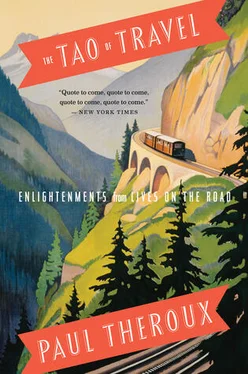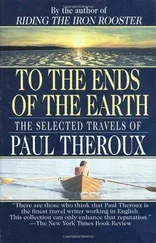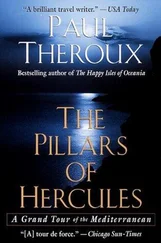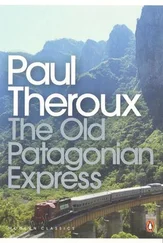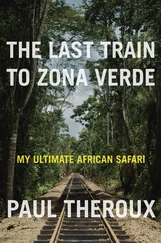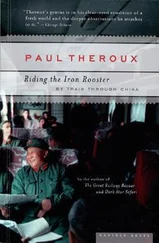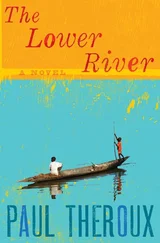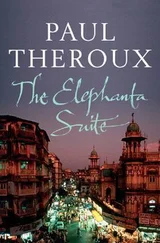In The Cruise of the Snark (1911), which was inspired by Slocum's voyage, Jack London wrote:
Joshua Slocum sailed around the world a few years ago in a thirty-seven-foot boat all by himself. I shall never forget, in his narrative of the voyage, where he heartily indorsed the idea of young men, in similar small boats, making similar voyage. I promptly indorsed his idea, and so heartily that I took my wife along. While it certainly makes a Cook's tour look like thirty cents, on top of that, and on top of the fun and pleasure, it is a splendid education for a young man — oh, not a mere education in the things of the world outside, of lands, and peoples, and climates, but an education in the world inside, an education in one's self, a chance to learn one's own self, to get on speaking terms with one's soul.
No Picnic on Mount Kenya
THE UNUSUAL ITINERARY in this book clearly illustrates one of the principal motives in travel: the wish to escape from boring, nagging, pestiferous people. That wish can inspire long journeys and ambitious travel feats.
In 1943, Felice Benuzzi (1910–1988) was bored and irritated with confinement and his annoying fellow Italians in a British prisoner of war camp outside the town of Nanyuki in Kenya. He was surrounded by "every kind of person… old and young, sick and healthy, crazy and sensible." He says that the lunacies and achievements of the other prisoners could fill a book, and he proves this with examples. But his mind was on other things. From behind the barbed wire of the camp Benuzzi had a view of majestic Mount Kenya: "An ethereal mountain emerging from a tossing sea of clouds framed between two dark barracks — a massive blue-black tooth of sheer rock inlaid with azure glaciers, austere, yet floating fairylike on the near horizon. It was the first 17,000-foot peak I had ever seen."
A junior colonial officer in Italian-controlled Ethiopia, he had been captured by British soldiers along with thousands of other Italians and imprisoned in the British colony of Kenya. (Benuzzi does not mention that other Italian prisoners, as forced laborers, helped build the western road out of Nairobi that traverses the Great Rift Valley, as well as a lovely chapel in one of the bends in the road.)
More than a year of imprisonment passed before he was able to choose two fellow prisoners, Giuan and Enzo, for his team. With great ingenuity they made ice-climbing equipment (crampons, axes) out of scrap metal, and they stockpiled warm clothes and food. "Life [in prison] took on another rhythm because it had a purpose." With a copied key and an attitude, they bamboozled the camp guards and broke out, leaving a letter behind for the prison authorities stating their intention and apologizing for the bother they might be causing.
Their climb took them through the lairs of leopards and lions, through dense bamboo forests and fields of lobelia. Enzo was ill; rations were often short; the cold and the necessity to avoid detection were also problems. Yet given the circumstances, they were equipped for the assault on the summit. Without a map, they used their judgment and experience of other climbs. They struggled upward, at times in deep snow, blazing their own trail. On one of their climbs they were in the snow and cold for eighteen hours. Although they were defeated in their attempt to reach Batian, the highest peak, they summited Point Lenana, 16,300 feet, where they left an Italian flag that was later found.
After their arduous climb they descended the mountain, returned to the prison camp, and surrendered. The punishment for escaping was twenty-eight days in solitary confinement, but the British camp commandant, saying he "appreciated our sporting effort," gave them seven days.
Yes, a sporting effort. But it was something else — a disgust with confinement and a wish, as herded-together prisoners, to reclaim their humanity. "Forced to endure the milieu [of the camp]," Benuzzi says early in the book, "we seemed almost afraid of losing our individuality." Thus Benuzzi and his comrades saw a kind of salvation in the climb, as many people see liberation in travel and the triumph of the will in a singular travel feat.
After the war, Benuzzi wrote his book, Fuga sul Kenya: 17 Giorni di Libertà, which was translated under the less-than-gripping title No Picnic on Mount Kenya (1952).
Benuzzi's experience parallels that of the German Heinrich Harrar, who was captured in India in 1939 when he was on his way to climb Nanga Parbat. Harrer was interned near Dehra Dun, in sight of the Himalayan foothills, the heights of which (as in the case of Benuzzi's glimpse of Mount Kenya) inspired him to escape. After repeated attempts he succeeded, in 1944, making his way to Tibet, a tale he recounted in Seven Years in Tibet (1953).
Rowing Across the Pacific
GÉRARD D' ABOVILLE ROWED a twenty-five-foot boat from Japan to Oregon in 1991 and wrote about it in Alone. He had previously rowed a boat across the Atlantic ten years earlier, from Cape Cod to Brittany. This had been done before, but no one had succeeded in rowing across the Pacific alone. He set out late in the season and was pummeled by heavy weather, tumultuous storms, and forty-six-foot waves. There are no islands in the North Pacific. A Russian freighter offered to rescue him. "I was not even tempted," d'Aboville says. But he repeatedly overturned in the high waves and nearly drowned on his final approach to the coast of Oregon.
After he completed his journey he quietly returned to teaching survival skills in his Outward Bound school in Brittany.
Riding a Horse from Buenos Aires to New York City
AIMÉ TSCHIFFELY (1895–1954), a Swiss, rode ten thousand miles by horseback to New York. He had two horses, Mancha and Gato, and it took him three years, from 1925 to 1928. He crossed the Andes, the Darien Gap, and the length of Mexico, but not until he got to the United States did he have a serious problem: he barely survived being deliberately sideswiped by a lunatic motorist. The whole story is told in his best-selling book, Tschiffely's Ride (1933).
Swimming the Panama Canal
RICHARD HALLIBURTON (1900–1939) described his swimming the Panama Canal in his second book of travel, New Worlds to Conquer (1929). He had swum the Hellespont in his first book, The Royal Road to Romance (1925). He specialized in travel feats — the first documented winter ascent of Mount Fuji, sneaking into the Taj Mahal at night and bathing in the tank by moonlight, and other efforts — some actual feats, some silly stunts. In Seven League Boots (1935) he traveled through Arabia and Ethiopia, where he met and dined with Emperor Haile Selassie. He has been described as a tormented homosexual and an imaginative traveler and thinker. In his last effort, attempting to cross the Pacific in a Chinese junk, the Sea Dragon, he was lost at sea and declared dead some months later.
His exuberant books, his purple prose, inspired a generation of youngsters to become travelers. In The Royal Road to Romance he wrote, "Youth — nothing else worth having in the world… and I had youth, the transitory, the fugitive, now, completely and abundantly. Yet what was I going to do with it? Certainly not squander its gold on the commonplace quest for riches and respectability, and then secretly lament the price that had to be paid for these futile ideals. Let those who wish have their respectability — I wanted freedom, freedom to indulge in whatever caprice struck my fancy, freedom to search in the farthermost corners of the earth for the beautiful, the joyous and the romantic."
Circling the Poles
BETWEEN 1979 AND 1982, Sir Ranulph Twisleton-Wykeham-Fiennes (aka Ran Fiennes) traveled fifty-two thousand miles around the world on a polar axis, the Transglobe Expedition, with a partner, Charles Burton; the trip was mostly over land. Fiennes also attempted a solo expedition to the North Pole, but crashed through the ice and took his frostbitten self away, abandoning the Arctic. Other Fiennes feats: by hovercraft up the Nile to discover the lost city of Ubar in Oman, and running seven marathons in seven days, after undergoing double bypass heart surgery. His memoir Living Dangerously (1987) is highly hubristic but a readable account of his exploits.
Читать дальше
